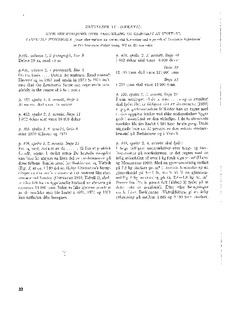| dc.description.abstract | Commercial harvesting of Laminaria hyperborea from the bottom has been carried out on the west coast of Norway since 1964. This alga, together with L. digitata and Ascophyllum nodosum, is used for alginate production. The harvesting apparatus is a seaweed dregde equipped with knives fixed at the front end and a trawl net to collect the plants. Two different models of the dredge have been designed for use by conventional fishing boats of 25 feet and 60—70 feet respectively. A boat of 57 feet, especially designed for the harvesting of L. hyperborea, has been in operation since 1969. The dredges are used at 1 — maximum 20 m depth, and the daily catch is normally about 6 tons of seaweed for smaller boats and 20—25 tons for large ones. Even larger catches are obtained with the 57 feet boat. L. hyperborea is currently being harvested on the west coast at about 59º N and near 63º N. This study was made in the southern area during short visits in the Kvitsøy district in 1968, 1969 and 1970. Some results from similar investigations at Hustadvika near 63º N are included. The harvesting technique on rocky and stony bottoms and the effects on the vegetation were observed by diving. The dredge works very efficiently on even, rocky bottoms and cuts off the stipe 5—20 cm above the holdfast; few plants are lost when the dredge is properly operated. The results are less satisfactory on loose bottoms where plants are easily overturned and missed by the dredge. The substrate can also be disturbed, and even large boulders may be turned over. The stumps soon decompose and have almost completely disappeared within a year. Subsequent observations and sampling at 4—10 m depth were made in areas harvested 2, 18, 24 and 36 months previously to study the repopulation. Harvested areas are soon reinvaded by new plants of L. hyperborea. Other species which occur in the area, may also develop at the same time and become locally dominant during the first three years after harvesting. The most important species are Desmarestia aculeata, D. viridis, Laminaria saccharina and Halidrys siliquosa. In general, these species were more common on stony than on rocky bottoms. L. hyperborea grows fast in cleared areas, and within a year a dense vegetation has developed. The number of plants per unit area is very high in young populations; in one case up to 153 plants of L. hyperborea per square meter were found at 5 m depth on a rocky bottom harvested 18 months previously. Stipe length had reached as much as 55 cm, and a maximum density of 6.0 kg per m(2 was recorded from the few samples obtained. The growth rate increases during the second and especially the third year after harvesting. The main stipe length of 13 tagged plants at 4 m depth in an area which had been harvested at Hustadvika, was 40 cm after two years and 95 cm after three years. The mean fresh weight of stipe and frond of the same plants were 304 g and 350 g respectively. These may be maximum values for L. hyperborea on the Norwegian coast . Three years old populations at Kvitsøy are very well developed and have been regularly harvested. On the basis of the harvested material it would appear that the density of L. hyperborea was aproximately 9 kg per m(2 after 3 years regrowth as compared to 10 kg per m(2 originally. The yield is surprisingly high: the plants are small at this stage compared with the size they can ultimately attain, but the number of plants per unit area is high. Observations on older populations indicate that a further year's growth, by which time the frond weight seems to have reached a maximum, would significantly increase the yield. Full grown plants at Kvitsøy may be at least 9 years old and have a stipe length of almost 200 cm. A density of up to 30 kg per m(2 of L. hyperborea has been recorded at 5 m depth in an old forest. Young plants have relatively smooth stipes with few epiphytes and provide better raw material than older ones. | en_US |
